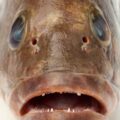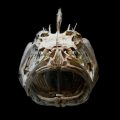Like any other species, groupers also have a tongue in their mouth. It is a very common question among people: what is the boney thing of the fish in the bottom of their mouth? This is the tongue of the fish. Almost all fish have a tongue. The tongues of fishes are not the same as those of humans. Those are different in their function.
Their tongues have a bony structure. This bony tongue is scientifically called basihyal. Those are not muscular and cannot move much. Its moving capacity is very limited. It has very little muscle. They use the tongue muscle to impel food backward. They cannot move their tongue like humans. They resemble tongues, but they are an organ for functions other than tasting food. Fish taste buds are placed all over their mouths, lips, and teeth. The tongue (basihyal) is placed on the floor of the mouth.
All animals have tongues, but the fish’s involvement of the tongue in chewing is not the same. Birds and mammals use their tongue to keep their food in their mouth, but fish use their tongue for different purposes, not for chewing or testing. Their functions are described here.

The function of the tongue in groupers
The grouper can’t taste its food with its tongue, but it uses its tongue to swallow and hold the prey in its mouth. It also helps to swallow quickly. They use their tongue muscles to channel their food farther into their mouths for more processing. It also helps them control the movement of oxygenated water from their mouth into their gills, which helps the grouper breathe.
They can use it to protect themselves, as well. If you closely watch your aquarium fish, you can see the basihyal when they open their mouth. It creates a barrier and protection for the mouth. Scientists say that the basihyal has developed to protect the ventral aorta of the fish. Predatory fish eat live fish, and the small fish can damage the inner mouth area, so basihyal helps to protect them from getting harmed by the predatory fish.
The ventral aorta is placed in the next part of the oral cavity floor. An aorta is a large-sized blood vessel that can transport blood. So, food can damage the aorta. That’s why the tongue protects it. So, the tongue has no similarities with humans; just the location is the same.
Research from Brown University shows that there is a set of teeth on their tongue. This tongue does not help with chewing, but it grinds the food without chewing. These teeth help to move the food from the mouth to the stomach through the throat. The prey fish could not move backward for this tooth. Usually, the small fish want to escape from the mouth, so those teeth of the tongue push them inside the fish.
Can groupers lose their tongue?
Yes, groupers can lose their tongue. Sometimes infection occurs in the groupers’ tongues, and the fish loses it. There are some parasites that lives on tongues, and they can create an infection. Within a very short time, the parasite eats the whole tongue. They do not die if the tongue is gone because a fish can live without a tongue.
The parasite which can attach to the basihyal is called Cymothoa exigua. It is a severe and common infection. The parasite is large in size, like crustaceans. They can be seen from the outside. This parasite sucks blood from the groupers and creates problems in the gills of the grouper. When the structure of the gills is not the same as before, they face respiratory issues. Their movement speeds decrease without it.
Their immunity also decreases after this infection. So, they do not die without a tongue, but they become weak and restless without it. The tongue is not a major body organ but has some functions. The functions may not be very important, but they help the fish live a healthy and joyful life. It also creates amenia in groupers. The parasite attacks the tongue. The function of the tongue is hampered. Then the ventral aorta is also damaged without tongues, but they still survive without a tongue like structure. They suffer from many issues and stress without it. So, if you buy a whole grouper for cooking, check the tongue before cleaning. If there is anything present like crustaceans in the mouth, cut it and throw it away. Sometimes people bake or fry a whole small-sized grouper and find some little creature inside the mouth.
Can Grouper Taste their Food?
Yes, Groupers can taste their food. Taste sense is very important for any fish, because they need to avoid any toxic and spoiled food. Fish have all five senses vision, touch, taste, smell, and hearing. Grouper does not taste their food with their tongue like humans, but they can taste their food with their senses. Taste and smell are closely related to the fish.
The chemical sense of fish is like humans, but those are not in the tongue. Those are located both over their skin and in the mouth. They can taste their food if they swim near the food. It means their taste buds work from a distance. They are covered with thousands of taste buds. Taste bad is sensory organs that receive the taste. They can understand what to put into their mouth through this sense. The taste receptor molecules are absent in the tongue but are the same as us. Even they can detect a wide variety of tastes, and chemical compounds, than us. More than sweet, sour, savory, salty, and umami.
Grouper nerve fibers that innervate the tastebud are placed within the bud’s nerve fiber plexus. Nerve fibers are located between sensory epithelium. This consists of basal cells and light and dark elongated cells. Taste buds do not always work properly for fish. Their taste buds can change because of temperature, water pollution, starvation, the odor of their prey, salinity of the water.











